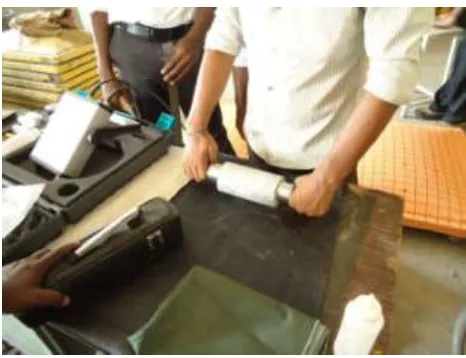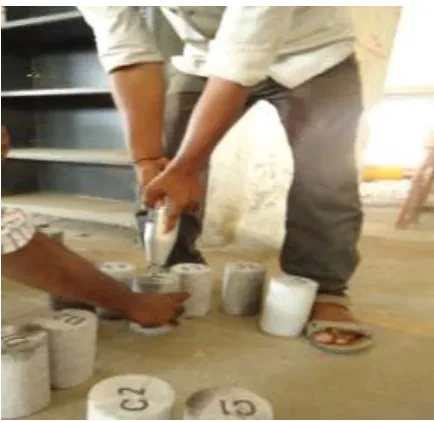Study on the Strength and Deformation Characteristics of
Rock Mass
S.Aravindan
1, DS.Vijayan
2, K.Ilayaraja
3Department of Civil Engineering, Bharath University, Selaiyur, Chennai, Tamilnadu, India.
ABSTRACT
This paper deals with the statistical analysis of the compressive strength and of the elastic
modulus of jointed rock masses under different confining pressures. Properties of the rock
masses with different joint fabric, with and without gouge have been considered in the analysis.
A large amount of experimental data of jointed rock masses from the literature has been
compiled and used for this statistical analysis. The compressive strength of a rock mass has been
represented in a non-dimensional form as the ratio of the compressive strength of the jointed
rock to the intact rock. In the elastic modulus, the ratio of elastic modulus of jointed rock to that
of intact rock at different confining pressures is used in the analysis. The effect of the joints in
the rock mass is taken into account by a joint factor. The joint factor is defined as a function of
joint frequency, joint orientation, and joint strength. Several empirical relationships between the
strength and deformation properties of jointed rock and the joint factor have been arrived at via
statistical analysis of the experimental data.
A comparative study of these relationships is presented. The effect of confining pressure on the
elastic modulus of the jointed rock mass is also considered in the analysis. These empirical
relationships are incorporated in a nonlinear FEM code to carry out the equivalent continuum
analysis of jointed rock masses. The method presented in this paper recognizes that the jointed
rock mass will act both as an elastic material and a discontinuous mass. The results obtained by
I. Introduction
Rock is a discontinuous medium with fissures, fractures, joints, bedding planes and faults. These
discontinuities may exist with or without gouge material. The strength of rock masses depends
on the behavior of these discontinuities or planes of weakness. The frequency of joints, their
orientation with respect to the engineering structure, and the roughness of the joint have a
significant importance from the stability point of the view. Reliable characterizations of the
strength and deformation behavior of jointed rocks are very important for safe design of civil
structures such as arch dams, bridge piers and tunnels.
II. Materials
The rock mass is collected from Pallavaram, and is found to be a igneous rock. The scientific
name of rock is charckonite. The intact rock mass is cored to the shape of cylinder. The
dimension of the specimen is 150x75mm (height x diameter). Laboratory test were performed on
cylindrical specimens. Ultrasonic measurement of compression pulse velocity(UPV),
compressive strength (UCS), dry unit weight(DUW), and saturated unit weight sets of rock
specimen is determined
IV. Experimental set up
By definition, the ultimate compressive strength of a material is that value of compressive
strength reached when the material fails completely. The compressive strength is usually
obtained experimentally by means of a compressive test. The apparatus used for this experiment
is the same as that used in a tensile test. However, rather than applying a tensile load, a
compressive load is applied. As can be imagined, the specimen (usually cylindrical) is shortened
as well as spread laterally.
Tensile testing, also known as tension testing, is a fundamental test in which a sample is
subjected to a controlled tension until failure. The results from the test are commonly used to
select a material for an application, for quality control and to predict how a material will react
under other types of forces. Properties that are directly measured via a tensile test are ultimate
tensile strength maximum elongation and reduction in area
Fig 3.ultrasonic pulse velocity
Ultrasonic Pulse Velocity tests are performed to assess the condition of structural Members with
two-sided access such as elevated slabs, beams, and columns. Voids, Honeycomb, cracks,
delimitation, and other damage in, wood, masonry, Stone, ceramics, and metal materials can be
identified and mapped with the method. UPV tests are also performed to predict strength of early
age concrete. The UPV test relies on direct arrival of compression waves. Sources and receivers
used in the tests have resonant frequencies ranging from 50 to 150 kHz.
This test method covers the testing apparatus, sampling, test specimen preparation, and testing
procedures for determining the rebound hardness number of rock material using aspiring driven
steel hammer, referred to variously as a rebound hammer, impact test hammer, or concrete test
hammer. This test method is best suited for rock material with compressive strengths (see Test
Fig 4. rebound hammer
Water absorption test gives an idea about the strength of the rock mass. Rocks having
more water absorption are more porous in nature and are generally considered unsuitable unless
they are found acceptable based on strength impact and hardness test. The specimen is washed
thoroughly to remove fines, drained and then placed in a wire basket and immersed in water at a
temperature for about 220 to 320 c and with a cover of at least 5 cm of water above the top of the
basket. Immediately after immersion the entrapped air is removed from the sample by lifting the
basket containing it above 25 mm above the base of the tank and allowing it to drop 25 times at
the rate of above one drop per second. The basket and the sample specimen should remain
Table 1: Summary of Test Results
V. Results And Discussions
The objective of the study was to determine the dynamic engineering properties as well as the
geotechnical and mechanical properties of charnockite rock. Hence rocks can be used for
construction in the pavements, parking areas, rock ornaments and in the platforms
S.NO SPECIMEN
SIZE IN mm
SPECIMEN
WEIGHT
(Kg)
COMPRESSIVE
STRENGTH
(N/mm2)
TENSILE
STRENGTH
(N/mm2)
REBOUND
NO
UPV in
mm/sec
1 150 x 75 2.009 36,000 17.217 54 4838
2 150 x75 2.004 45,000 16.663 42 4068
3 150 x75 2.067 42,000 14.441 46 4225
4 150 x75 2.087 32,000 16.107 54 4740
5 150 x75 2.058 26,000 16.663 54 4850
6 150 x75 2.036 38,000 17.773 50 3304
7 150 x75 2.048 35,000 17.217 54 3670
8 150 x75 2.008 40,000 16.107 54 3770
9 150 x75 2.003 34,000 14.996 54 4775
10 150 x75 2.056 39,000 16.107 42 3479
11 150 x75 2.067 29,000 16.663 50 3686
12 150 x75 2.049 30,000 14.441 54 3068
13 150 x75 2.058 44,000 14.996 46 4164
14 150 x75 2.060 34,000 16.663 54 4854
The objective of the study was to determine the dynamic engineering properties as well as the
geotechnical and mechanical properties of charnockite rock. Hence rocks can be used for
construction in the pavements, parking areas, rock ornaments and in the platforms.
References
1. ASTM (2008), ASTM D4543-08, standard practices for preparing rock core as
cylindrical test specimen and verifying conformance to dimensional and shape
tolerance.
2. ASTM (2010), ASTM D7012-10, standard test method for compressive Strength and
elastic modules of intact rock core specimens under varying status of stress and
temperatures.
3. ASTM (2008), D5731-08, standard test method for the determination of the point
load strength index of rock and application to rock strength classification.
4. ASTM (2002), D3148 standard test method for elastic modules of intact rock core
specimen in uniaxial compression.
5. HOEK, E. and BROWN, E.T. (1980), Empirical strength criterion for rock masses,
J.Geotech. Eng. Div. 106(GT9), 1013-1035.
6. KAHRAMAN, S. (2001), evaluation for simple method for assessing the uniaxial
compressive strength of rock, international journal of rock mechanics and mining



